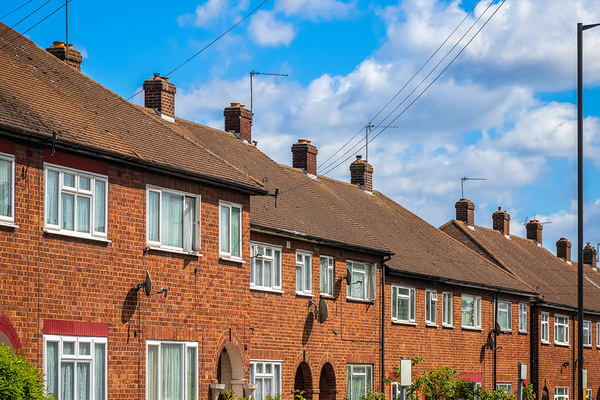You are viewing 1 of your 1 free articles
London’s £4bn Affordable Homes Programme: how will it impact development in the capital?
Last week, the Greater London Authority unveiled the details of its upcoming £4bn Affordable Homes Programme. Lucie Heath explores the major changes and speaks to sector figures about how the new programme could impact development plans
According to London mayor Sadiq Khan, “affordability and quality” sit at the centre of the next Affordable Homes Programme (AHP) in London. On first glance, the new £4bn programme has a lot to offer social landlords, including the commitment that 50% of the homes being delivered via the programme are to be for social rent.
However, the new AHP marks a big change in how affordable housing grant is delivered in the capital, meaning development plans are likely to be altered as a result. Inside Housing dives into the key changes.
Social rent
The most headline grabbing part of the Greater London Authority’s (GLA) new AHP is that 50% of the homes delivered will be for social rent. This can be compared to the GLA’s current programme, which stipulates that at least 58,500 (65%) of the 90,000 homes delivered via the programme are to be for shared ownership or London Living Rent, a tenure designed to allow middle-income Londoners to save for a home. The majority of the rest of the homes funded by the current AHP are set at London Affordable Rent, which is usually slightly more expensive than social rent.
“At the moment grant funding accounts for about 14% or 15% of the total funding for our development. That’s not a huge amount given the level of affordable homes that we’re being asked to provide”
Helen Evans, chair of the G15 group of housing associations, says that social landlords “always want to orientate our programmes around social rent”, but that housing associations will need more grant to deliver these homes, meaning the total number of homes being delivered via the AHP is likely to be smaller.
Guy Slocombe, chief investment officer at Hyde, explains further: “At the moment grant funding accounts for about 14% or 15% of the total funding for our development. That’s not a huge amount given the level of affordable homes that we’re being asked to provide, and now that we’re looking at 50% of affordable homes being social rent rather than London Affordable Rent, that viability gap increases. So we need to look at ways, working closely with the GLA, to determine how that viability equation works going forward.”
A decline in the total number of homes being delivered via the AHP appears to be a sacrifice the GLA is willing to make to boost the supply of high quality social housing in the capital. While the current £3.15bn programme aims to deliver 90,000 homes between 2016 and 2021, the next £4bn programme aims to deliver 82,000 within the same time frame.
Housing standards
Another change to the upcoming GLA programme is a number of new requirements around building safety, quality and environmental standards. All homes funded through the programme will be banned from using combustible materials on the external walls of any building and will be required to meet certain space standards, as well as having private outdoor space.
Developments of 10 or more homes will need to be zero carbon, which in practice means adhering to six sustainability standards that reflect those set out in the mayor’s draft London Plan.
Vicky Savage, London managing director at L&Q, says the organisation “welcomes the importance given to quality in the programme”.
“Of course, from a shared ownership perspective if you’re selling a lower share you’re getting a lower capital receipt, which means you either need more internal subsidy or more grant to support that”
“This is a major issue for the housing sector which we have to get right. We also share the values that safety, space and sustainability should be front and centre of the new homes we build in the capital,” she says.
Mr Slocombe agrees: “Building safety, environmental standards, decent home standards or space standards are all characteristics that Hyde fundamentally supports and are built into our own corporate strategy, so we will do that anyway, but of course it’s going to cost us more.
“Looking into some of the modelling we’ve done around our future homes and environmental standards, we’re looking at somewhere in the region of 10% to 13% additional costs. This all impacts viability. We are having very productive discussions with the GLA and we know they understand.”
Shared ownership
Like with the wider AHP delivered by Homes England in the rest of the country, all homes funded under the GLA’s programme will be subject to the Right to Shared Ownership and will be forced to adhere to the government’s new shared ownership model. Housing associations have previously expressed a number of concerns about both of these initiatives, some believing that the new product could make the tenure unviable. One particular sticking point is the reduction in the initial share required to purchase a shared ownership home from 50% to 10%.
Ms Evans explains: “The Right to Shared Ownership and the new shared ownership model is a significant issue for many providers and that’s something else that will be getting a lot of consideration, because, of course, from a shared ownership perspective if you’re selling a lower share you’re getting a lower capital receipt, which means you either need more internal subsidy or more grant to support that.”
The rules around shared ownership are therefore likely to be another factor that will increase the average grant rate needed for each new home within the GLA’s programme.
Grant rates
Perhaps in acknowledgement of the increased per-unit costs facing developers under the programme, the GLA has decided not to set fixed grant rates for this AHP, but instead will negotiate grant rates on a case-by-case basis. This means that the GLA will not be deciding how much grant each tenure will attract. Instead developers will be asked to provide a number based on their own viability assessments.
“It means that you are assessing the financial viability of your bid according to what you need in grant to make it viable, rather than looking at what’s available and seeing if it will be viable,” Ms Evans explains.
“It probably will encourage people to bid because they will look at what they need to make a viable bid according to the conditions of the programme and we’ll ask for grant accordingly. It will allow the GLA to take what they consider to be the best value for their money from the bids that they get.”
Ms Savage says L&Q has worked with both negotiated and fixed grant rates over the years. “Building in London is a challenge, and the more certainty we have on grant rates the better, as this helps us to reduce our risk when we bid for land and make investment decisions,” she says. “We enjoy an excellent trust-based relationship with the GLA, and seek to maintain an open dialogue over our projects at all times to help with this.”
Regeneration
The new rules around regeneration in the new AHP have perhaps caused the most controversy within organisations. Guidance for the new programme states that “funding will not be available for units that replace homes that have been, or will be demolished”.
This brings London’s programme in line with the wider AHP in England, which also does not provide grant funding for replacement homes.
Ms Evans says this rule marks “a big change from previous programmes”, adding that “the extent to which it makes a difference will depend on how much the estate is being densified”.
“I believe estate regeneration, which already involves additional costs of demolition and loss of rental income, will become more expensive and unviable in some instances,” she says.
“Having been slightly cautious about the London market for the last two or three years, we’re now looking at London very keenly”
In its guidance, the GLA has said it will consider funding replacement homes in “exceptional circumstance”, where homes have become “obsolete”.
“I hope it’s a broad generalisation,” says Mr Slocombe on the new rule. “Because some of the homes that are being regenerated are being regenerated because they are no longer fit for purpose. Hyde has experience of large-scale regeneration, which involves replacing homes that would not meet the decent homes standards. I believe that grant should be provided to replace these homes, and I hope that using a similarly negotiated route, regeneration projects will be considered on their own merit.”
Ms Savage says L&Q is “considering the implications of the grant funding conditions for regeneration projects closely, as these may have an impact on the future delivery of schemes”.
Impact on development
Despite the increased costs of development, not to mention the building safety and decarbonisation costs faced by many organisations, housing associations insist they are not shirking away from developing in the capital.
“Having been slightly cautious about the London market for the last two or three years, we’re now looking at London very keenly,” says Mr Slocombe, adding that Hyde has just bought a site in Croydon and is looking at three other schemes that would together deliver around 1,500 homes.
Ms Evans says the appetite of housing associations to build in London will “vary significantly” depending on their “exposure to the building safety situation” and “the extent to which cross-subsidy from sale can be replaced by higher grant rates”.
“But then there’s the variable grant rate, so people will bid for what they think makes it worth their while to carry on developing,” she adds.
Equality and diversity
Finally, the GLA’s programme also sets out a series of conditions around equality, diversity and inclusion that providers will need to follow if they are to receive funding. These include offering diversity and inclusion training for all employees, broadening recruitment channels to encourage applications from under-represented groups, and publishing gender and ethnicity pay gaps.
“I think the equality, diversity and inclusion requirements are welcome, because it gives you an organisational nudge towards what’s already an aspiration and it’s sort of institutionalises that,” says Ms Evans.
Sign up for our Week in Housing newsletter
Already have an account? Click here to manage your newsletters














